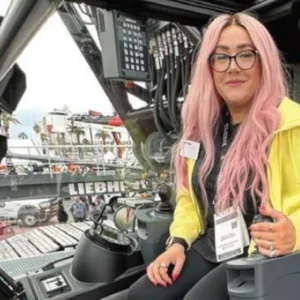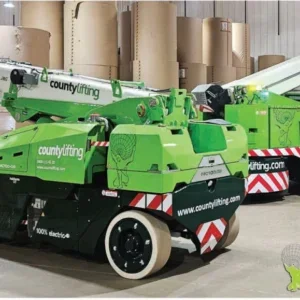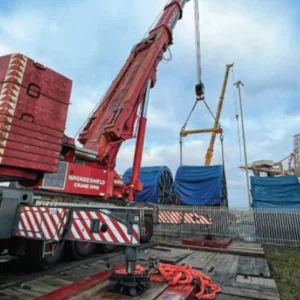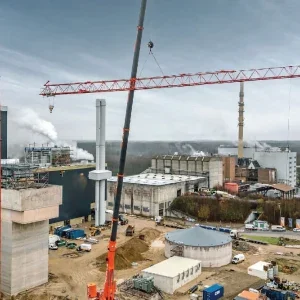The service — or mechanics — truck concept is the answer to avoiding costly downtime of machines in the field needing maintenance and repair. The complete service truck is made up of several components; a chassis, truck body and a crane with a winch line installed on the rear platform. The winchline means loads can be lifted and lowered very accurately, as long as the crane is positioned in the right place above the load. The truck body holds spare parts and tools and equipment that service technicians need to complete a job in the field. The straight boomed crane can lift heavy components up to seven tonnes and most are radio and/or remote controlled.
Originating from the oil fields of Oklahoma where their function was to replace oil wells, service trucks are now used to service, maintain and repair heavy equipment such as earth moving machinery on road paving projects, agriculture machines, demolition equipment and mining machinery.
"Mechanics trucks are basically the field mechanic’s office, or workshop, on wheels and need to accommodate everything from a laptop for diagnostics to a coffee machine!", says Tim Davison, Product Manager, Bodies and Cranes at Stellar Industries. "The operator could be holding tens of thousands of tools in his truck, and be working from 5am until well into the night. It’s his home from home as well as being a crucial part of the life cycle of machinery out in the field."
Stellar Industries was established in 1990 as the first North American corporation to design and manufacture the hydraulic hooklift. It entered the telescopic crane market in 1999 with the industry’s first hexagonal shaped boom design with a 28 feet hydraulic reach, a radio remote control as a standard feature, and a planetary winch speed of 60 ft/min. Today the full crane line is available in models that range in capacities up to 14,000 pounds and offers the most complete turnkey packages available to the mechanics truck market. "Most manufacturers produce one or two components of the service struck, e.g the truck body or the chassis", continues Davison, "but we offer a complete mechanics truck package. We have eleven packages in our range, all available with a heavy duty steel body, air compressor, drawer systems with added options.
"Our packages range from the 3315 electric/hydraulic crane, designed to meet the needs of public utilities, municipalities, water works, construction companies and others requiring an electric/hydraulic crane in the medium lifting range, to the 14528 telescopic crane. The 14528 was developed as a result of customer demand for greater reach and increased capacity. It serves the increasing demands of heavy equipment dealers, the mining industry and large construction companies who operate sizeable fleets with even larger equipment needing service. This was an industry first at time of launch with the full hydraulic reach to 28 feet. The 14528 can lift a maximum of 14,000 pounds at five feet and 2,950 pounds at 28 feet, and, with the addition of the Moment Indicator (LMI), overloading the crane is not possible."
"Mid range is the 7621 telescopic crane which is our best seller in its class", continues Davison. "With a maximum reach of 21 feet and load lift of up to 7 tonnes, the 7621 is most used by our fleet customers and heavy equipment dealers. It incorporates two hydraulic extensions so the operator doesn’t need to manually pull out the extension."
Made in the USA
Venco Venturo is one of the leading manufacturers of cranes and crane bodies for the service truck market. The company began life as Collins Associates in 1952, founded by Arden "Art" Collins. In September 2013, Brett Collins and his management team of Dave Foster and Mike Strittholt bought the organisation that was then named Venturo Manufacturing. The new owners changed the name to Venco Venturo Industries and the company’s specialised line of cranes and hoists continues to grow and develop with Collins’ third generation experience.
"The truck machinery industry is highly fragmented", says Brett Collins, Venco Venturo’s President.
"The truck machinery industry is highly fragmented. I’d say there are approximately 15-20 manufacturers in the service truck industry, and that’s just manufacturers of cranes and crane [truck] bodies. It’s a misconception that it’s dominated by a few key players."
Indeed, almost all of the major service crane manufacturers now design and make their own lines of mechanics trucks and bodies. In addition to Venco Venturo, these include Autocrane, Teamco (a South Dakota-based manufacturer which acquired the assets of Feterl service body and crane product lines from BII Fargo Incorporated in 2011). Jomac, Maintainer, Omaha Standard Palfinger, Iowa Mold Tooling, Stahl and Stellar Industries.
"You have the chassis manufacturers like Ford, Peterbilt, Kenworth and Frieghtliner Trucks", continues Collins. "And then of course the upfitters who complete the final vehicle and install the components that make up the service truck. This could be an air compressor installed for running tools, central hydraulics to operate the crane, a welder. There can be many variations of the actual truck, depending on its application, but almost all will have a crane mounted."
Collins continues, "Our most popular product is our ET12KX. It’s an electric crane with a lifting capacity of 12,000 pounds and runs off a 12v battery. It’s a relatively small crane compared to our other products but it suits a lot of our customers’ needs.
"Our biggest market is propane and the cranes and trucks we use for those customers are slightly different to the more traditional purpose of a mechanics truck. For those jobs, the service trucks are used for material handling. For example, a propane gas customer will need propane tanks delivering to their customers and installing so need a crane and equipment to do that. That requires a more heavy duty crane than the ET12KX. For that work, our most popular product is the HT40KX. This is a hydraulic crane powered by PTO. It’s the workhorse for our proprane customers and our best product for that market.
Rick Cummings, Vice President of Mulhern Gas clearly agrees. "We purchased a rack style truck equipped with the HT40KX crane to set propane tanks for our customers," he says."We were looking for one piece of equipment that could handle all of our tank lifting and moving needs. It handles even the large 1,000gallon propane tanks, often with heavy pumping equipment attached, with ease. The generous reach of its boom allows us to place our equipment even in the most difficult locations.
"Moreover, the remote control feature of the HT40KX crane allows a single operator to do the work of two or more. As we don’t need to be close proximity to the vehicle, one person can now set equipment with precision as he guides loads himself into the exact location. We can send one technician out for the day to do a range of jobs that used to require several men. It’s been so successful for us that we’ve even been asked by our competitors for assistance in some of their challenging tank placements and retrievals."
Iowa Mold Tooling (IMT) is one of the biggest manufacturers in the sector. Their mechanics trucks are typically equipped with a service body, telescopic crane and air compressor and used to perform repairs and maintenance on all types of on-site equipment. When machinery breaks down or preventive maintenance needs arise, IMT mechanics trucks bring shop capabilities to the equipment to minimise costly downtime.
IMT offers a complete lineup of mechanics trucks to meet specific application requirements. Their crane lineup includes a range of electric and hydraulic telescopic cranes with maximum capacities ranging from 950 to 14,000 pounds (430 to 6,350 kg) and up to 30 feet of reach.
Terry Cook, IMT’s product manager of commercial products believes that the most important factor to consider when selecting a mechanics truck is getting the specification right from the start. "Failure to properly specify the truck could result in costly under- or over-utilisation," he says. "Buying a truck that is too large for the application will not provide maximum return on investment, while a truck that is too small could lead to unmet needs and a higher cost of operation."
Cook continues, "the specification process should begin with one question: ‘How do I intend to use the truck?’ Specific needs for lifting, storage, payload, air supply, lubrication, welding and roadability should influence selection.
"One overarching point to remember is that mechanics truck specifications are highly interdependent. When specifying such a vehicle, lifting needs dictate crane size, which governs the size of the body. Crane size, body size and required payload combine to decide the size of the chassis. The required tools included on the truck, combined with other air needs, will determine whether a rotary-screw or reciprocating air compressor is added."
Maintainer has been manufacturing and selling heavy duty customised service bodies, service body cranes and lube bodies since 1976. Their products have evolved greatly since the first body design — the Basic Maintainer Body — a flatbed with a fixed boom crane mounted behind the cab. In 1981 they launched the first one tonne pressurised storage system service body with a 6,000 pounds capacity full hydraulic telescoping boom crane. This new body and crane combination had extra large cabinets and cargo space plus optional work bench bumper and met specific needs of their customers. In 1984, as a result of increasing demand, the company introduced a two tonnes version with an 8,000 lb. capacity crane. In 2013, Maintainer launched the H10034 crane – a new 34 foot hydraulic crane for its line of work truck cranes. This four section crane has the largest reach offered in the service truck industry. It’s rated at 10,000 pounds maximum capacity and can be installed on Maintainer’s newly designed two tonnes truck body.
Stahl’s SCX line of truck crane bodies marry with their range of cranes, from a five feet boom reach up to a reach of 30 feet. The company has been active in the market since 1946. The maximum lifting capacity of the 8000LRX-30-H is 8,000 pounds. "We are most competitive in the market for small lift requirements", says Joe Halpin, Inside Sales Manager at Stahl.
"We’ve carved a niche in the service trucks market for cranes on smaller trucks up to Class 5. These are mostly 1.5 — 2 tonnes cranes."
A local market
For an industry, which is shortly reaching its 30 year anniversary, the service truck market hasn’t ventured too far from its origins. Stellar Industries is one manufacturer who has attempted to take the mechanics truck market to Europe. "We have worked in Germany to try and get the concept to catch on", says Davison, "But it hasn’t taken off in the same way as it has here [the USA]. I guess the geography of the US lends itself to this kind of service concept, whereas in Europe you have a far greater density of service centres.
Not surprisingly then, manufacturers of these cranes are almost exclusively North American, with one notable exception of Austrian-owned Palfinger. Palfinger North America Group entered the service truck market in 2010 with a new range of cranes designed for service truck bodies manufactured by their acquired company Omaha Standard. There are nine cranes in the product line, ranging from capacities of between five and eleven tones and a reach of up to 29ft Other features include an internal integrated two block damage prevention system built into Palfinger winches; wireless remote control fitted as standard on all models with manual override controls and SAE hoses with JIC fittings for easy field maintenance.
So then, with opportunities seemingly limited to the US market, where are the areas for growth? "The agriculture sector is our biggest growing market and we continue to notice an increasing demand there", says Davison at Stellar. "The recovering construction segment was down for so long that it feels like a new market", says IMT’s Cook. "We are continuing to explore new export markets, fracking and other opportunities to grow and diversify our business. And of course there are always opportunities to enhance our products, as well as meeting challenges that the market throws up. Service truck manufacturers continue to enhance safety and stability features for safer equipment operation, and improve lift-to-weight ratio for increased payload. Higher-strength steel is often being used to achieve lift-to-weight ratio improvement. We’re also seeing a trend toward the use of fully integrated power units instead of a PTO to manage fuel consumption, environmental impact and chassis wear and tear.
"Today’s equipment is more complex and often requires technicians to undergo electronics training", continues Cook. "These factors have contributed to a technician shortage, which can impact demand for new service trucks.
Halpin agrees. "Crane operators are moving to becoming formally certified," he says. "In fact Stahl recently partnered with Nationwide Crane Training to create a first of its kind class for service truck crane operators to achieve certification in line with new OSHA regulations.
Under these new regulations, any service truck crane operator engaged in construction will have to be STC certified by 2017. This includes some delivery drivers and service individuals as well as construction company employees.
"We’re also seeing the oil and gas sector as an emerging market", continues Halpin. "New technology is bringing the ability to get at more resources and there are three or four regions where business is booming and producers are buying a lot of equipment."
"Another challenge we’re facing is increasing design complexity", says Cook. "This is driven by higher demand for custom configurations of our equipment".
Healing Cats
NMC Nebraska’s Caterpillar dealer provides full maintenance and repair support to fleet owners and rental customers. Through locations in Nebraska, Iowa, South Dakota, North Dakota and Utah, NMC offers a line of equipment, parts and services for many industries.
"It’s all about taking care of the customer in the quickest and most efficient way," says Dwight McDermott, director of service for the Cat Machine Group at NMC. Guided by that philosophy, NMC recently expanded its field service capabilities with the acquisition of smaller mechanics trucks — vehicles ideal for servicing compact machinery.
NMC noticed a need for smaller service trucks a few years ago. The field service department was too frequently asking fleet owners to haul their broken-down compact equipment into the shop for repair. Technicians were forced to swap out rental customers’ compact machinery more than seemed necessary. Cramped jobsites posed challenges.
NMC explored multiple options before adding Dominator CS, DSC12 and DSC20 mechanics trucks from Iowa Mold Tooling Co. Inc. (IMT) to its service fleet. Each truck body features an integrated IMT 3203i electric telescopic crane offering 4,000lb of maximum lift capacity and a maximum 15ft of horizontal reach.
McDermott says the IMT truck crane packages have had a significant impact on the service department’s efficiency, customer service and bottom line.
"We’re able to do more work in the field than we were before," McDermott says. "We don’t have to have machines hauled in for work like in the past. We can send a smaller truck out and still pull a hydraulic pump or an engine. We can still pick up and install a track on a skid steer or pull the drive motor out of a skid steer. On the rental side, we don’t have to swap out as many machines as we used to.
"Our fuel costs are less; our maintenance costs are less. Plus, we’re able to get to more jobs in one day, which obviously is more revenue."
Maneuvering in tight environments has become easier, too. McDermott lists basements, apartment complexes and parking garages as examples of space-challenged jobsites that are more accessible thanks to the smaller truck packages.
"If you’ve got some kind of major problem with a machine, it’s quite the chore to get out of those places and into a shop," McDermott says. "To be able to go out and repair those machines right where they sit is a big asset to those customers. It ultimately relates to more uptime for them."






